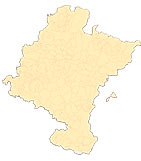pathway Teresian in the rest of Navarre
Neapolitan image of Tudela cathedral
From Naples, in the south of Italy, some singular sculptures arrived in Navarre, always through outstanding personalities who had been captivated by the aesthetics of that Hispanic viceroyalty.
The first temple in Tudela also received a pair of carvings - Saint Joseph and Saint Theresa - which were destined for the canons' chapel and later moved to the main sacristy. Both were a donation from one of the deans of that temple, Don Sebastián Cortés y Lacárcel, a native of Olmedo. The aforementioned prebendary was at the head of the main dignity of the Tudela chapter, according to the Catalog of its deans by Juan Antonio Fernández, between 1693 and 1703. Prior to his appointment as dean of the collegiate church of Tudela, he had belonged to the committee Supreme Council of Italy and Castile and presided over the Treasury Council. His merits led him to be General Commissioner of the Holy Crusade, in 1701, reason why the City Council of Tudela ordered to carry out public rejoicings and to paint some cheers to Jacinto de Blancas in 1702. According to several testimonies, he did not reside with assiduity in the capital of the Ribera de Navarra. He took possession by procurator in 1694 and died in the capital of Spain, where he usually lived, at the beginning of 1703.
position In order to enjoy his dignity in Tudela, he made the mandatory profession of faith in the hands of the Archbishop of Caesarea in the city of Naples, where he served as the King's lieutenant in the Chamber of Naples. This circumstance would lead him to acquire some artistic pieces that, for their quality and beauty, attracted the attention of all the Spaniards who traveled to those lands in southern Italy. The image of Saint Teresa arrived in Tudela during the Dean's lifetime, while the other one, at the request of the Tudela chapter, arrived after his death, and had to be requested from his executors, being brought from Madrid at the cost of the chapter.
The image of St. Teresa is the best quality. It presents the saint according to the models popularized from the very moment of her canonization, in her facet of writer inspired by the Paraclete, ready to write and dressed in the Carmelite habit and mantle. It is in this last one where some polychrome works are developed based on very colorful bouquets of flowers and typical of the Neapolitan school. In the face of the saint, the sculptor has used the gouges in a very special way.
-
ARRESE, J. J., Arte religioso en un pueblo de España, Madrid, CSIC, 1963.
-
GARCÍA GAÍNZA, M. C., "El convento de Carmelitas Descalzas de Lesaca", bulletin del seminar de Arte y Arqueología de Valladolid, 39, 1973, pp. 333-344.
-
FERNÁNDEZ GRACIA, R. and ECHEVERRÍA GOÑI, P. L., "El convento e iglesia de los carmelitas descalzos de Pamplona. Architecture", Príncipe de Viana (1981), pp. 787-818.
-
ECHEVERRÍA GOÑI, P. L. and FERNÁNDEZ GRACIA, R., "El convento e iglesia de los carmelitas descalzos de Pamplona. Exorno artístico", Príncipe de Viana, 164, 1981, pp. 819-891.
-
LABEAGA MENDIOLA, J. C., "Reliquary, autograph and images of Saint Teresa of Jesus in the Parish of Santa María de Viana", Príncipe de Viana, 164, 1981, pp. 893-91.
-
FERNÁNDEZ GRACIA, R. and ECHEVERRÍA GOÑI, P. L., "Fundaciones del Carmen Descalzo en Navarra", Santa Teresa en Navarra. IV Centenary of her death, Pamplona, Grafinasa, 1982, pp. 13-25.
-
ECHEVERRÍA GOÑI, P. L. and FERNÁNDEZ GRACIA, R., "Aportación de los Carmelitas Descalzos a la Historia del Arte Navarro. Tracistas y Arquitectos de la Orden", Santa Teresa en Navarra. IV Centenary of her death, Pamplona, Grafinasa, 1982, pp. 183-230.
-
FERNÁNDEZ GRACIA, R. and ECHEVERRÍA GOÑI, P. L., "Notas para un estudio iconográfico de Santa Teresa en Navarra", Santa Teresa en Navarra. IV Centenary of her death, Pamplona, Grafinasa, 1982, pp. 231-284.
-
ECHEVERRÍA GOÑI, P. and FERNÁNDEZ GRACIA, R., "Vicente and Carlos Berdusán, painters of Santa Teresa. Nuevos lienzos en Pamplona y Lazcano", Santa Teresa en Navarra. IV Centenary of her death, Pamplona, Grafinasa, 1982, pp. 283-298.
-
LABEAGA MENDIOLA, J. C., "Cartas de Santa Teresa de Jesús en Navarra", Santa Teresa en Navarra. IV Centenary of her death, Pamplona, Grafinasa, 1982, pp. 137-182.
-
AZANZA LÓPEZ, J. J., Arquitectura Religiosa Barroca en Navarra, Pamplona, Government of Navarre, 1996.
-
FERNÁNDEZ GRACIA, R., El monasterio de Fitero. Arte y Arquitectura, Panorama Collection, Pamplona, Government of Navarre, Institución Príncipe de Viana, 1997.
-
AZANZA LÓPEZ, J. J., Arquitectura y religiosidad barrocas en Villafranca (Navarra), Pamplona, Grafinasa, 1999.
-
FERNÁNDEZ GRACIA, R., El retablo barroco en Navarra, Pamplona, Government of Navarre, 2003. CARRETERO CALVO, R., "Fundación y construcción del convento de carmelitas descalzos de San José de Tudela /(Navarra), 1597-1603)", Príncipe de Viana (2007), pp. 59-99.
-
FERNÁNDEZ GRACIA, R., "Algunas esculturas napolitanas en Navarra", Pulchrum. Scripta in honorem Mª Concepción García Gainza, Pamplona, Government of Navarre, department de Cultura y Turismo. Institución Príncipe de Viana, 2011, pp. 300-310.












